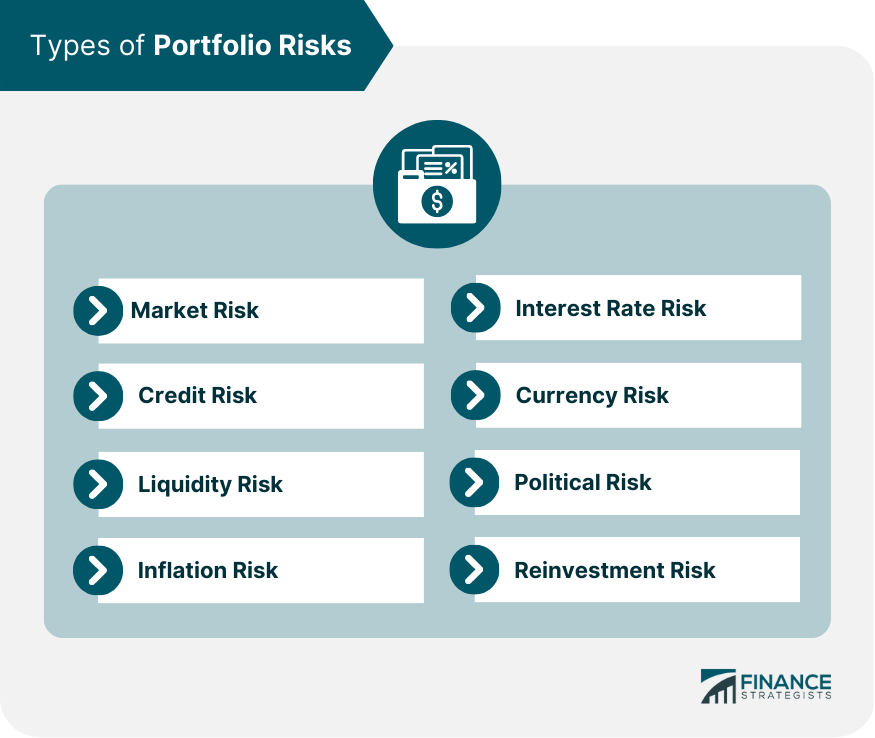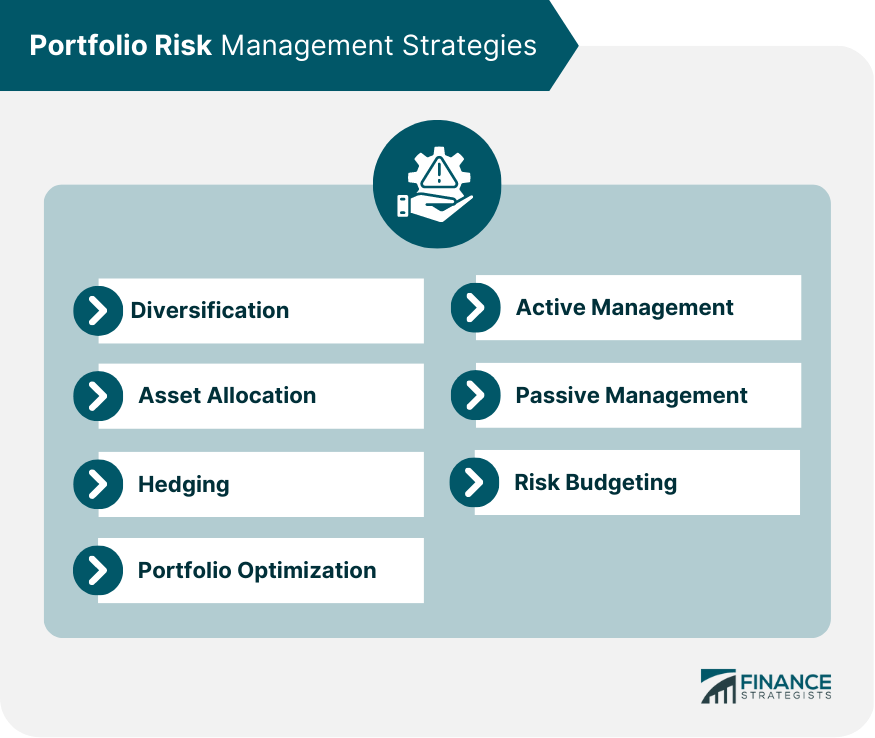Portfolio risk is a term used to describe the potential loss of value or decline in the performance of an investment portfolio due to various factors, including market volatility, credit defaults, interest rate changes, and currency fluctuations. Portfolio risk management is the process of identifying, evaluating, and mitigating the risks associated with an investment portfolio. Understanding the different types of portfolio risks is essential for investors looking to manage their portfolios effectively and mitigate risks associated with their investments. This is also known as systematic risk or the risk that an investment will decline in value due to macroeconomic factors that affect the entire market. These factors include interest rate changes, inflation, geopolitical events, and economic recessions. Market risk cannot be eliminated through diversification and affects all investments to some degree. This risk involves an investment that will decline in value due to a default by the issuer of a bond or other debt instrument. This is most prevalent in corporate bonds, where the issuer's creditworthiness is a major determinant of the bond's value. This risk involves an investment that cannot be sold or liquidated quickly enough to avoid losses. Usually, it can occur when there is a lack of buyers in the market or when the investment is illiquid by nature, such as real estate or private equity. This risk pertains to the purchasing power of an investment that will decline due to increases in the general price level of goods and services. The most affected investments are those with a fixed return rate, such as bonds. The risk involves the value of an investment that will decline due to changes in interest rates. This risk affects fixed-income investments, such as bonds, more than equity investments. The risk refers to the value of an investment denominated in a foreign currency that will decline due to changes in exchange rates. In particular, this is relevant for investors who hold international investments or invest in assets denominated in a foreign currency. This risk refers to investments that will decline in value due to changes in government policies, regulations, or instability in a particular country or region. This risk may come in the form of future cash flows from an investment that will be reinvested at a lower rate of return. Mostly, this is relevant for investors who hold bonds or other fixed-income investments with a maturity date. These measures of portfolio risk provide investors with a comprehensive view of the risk associated with their investment portfolio and can help them make informed investment decisions. Standard deviation is a measure of the dispersion of returns around the mean of a portfolio. It is a widely used measure of portfolio risk and represents the volatility of the portfolio. Beta measures the sensitivity of an investment's returns to changes in the overall market. A beta of 1 indicates that the investment's returns move in line with the market, while a beta greater than 1 indicates that the investment is more volatile than the market. VaR is a statistical measure of the maximum potential loss that a portfolio may experience over a given time period with a certain level of confidence. CVaR, also known as expected shortfall, is a risk measure that looks at the expected loss beyond a certain threshold. For example, a 95% CVaR of $5 million means that the portfolio is expected to lose no more than $5 million over a 1-year period with a 95% probability, but if the loss exceeds $5 million, the expected loss is the average of all losses beyond that threshold. A drawdown is a measure of the decline in the value of a portfolio from its peak value to its lowest point. It is a useful measure of portfolio risk for investors who are concerned about the potential loss of capital. Sharpe ratio is a risk-adjusted measure of portfolio performance. It measures a portfolio's excess return over the risk-free rate relative to its volatility. The Sortino ratio is a risk-adjusted measure of portfolio performance that takes into account the downside risk. By employing these strategies, investors can mitigate potential losses and create a portfolio that is consistent with their investment objectives and risk tolerance. Diversification is a strategy that involves investing in a variety of assets to reduce the overall risk of the portfolio. The idea behind diversification is that not all assets will perform poorly at the same time, so losses in one asset can be offset by gains in another asset. Asset allocation is a strategy that involves dividing a portfolio among different asset classes, such as stocks, bonds, and cash. The goal of asset allocation is to create a portfolio that is consistent with the investor's risk tolerance and investment goals. Hedging is a strategy that involves using financial instruments, such as options or futures contracts, to offset the risk of a portfolio. For example, an investor who is concerned about a decline in the value of a particular stock can purchase a put option to protect against losses. Portfolio optimization is a strategy that involves selecting the optimal mix of assets to maximize the expected return of a portfolio while minimizing the risk. This strategy involves using mathematical models to analyze different investment scenarios and select the optimal portfolio. Active management is a strategy that involves making investment decisions based on market conditions and individual security analysis. Passive management is a strategy that involves investing in a portfolio that tracks a market index, such as the S&P 500. This strategy is popular among investors who prefer a low-cost, low-maintenance approach to investing. Risk budgeting is a strategy that involves allocating risk across different investment strategies or asset classes. The goal of risk budgeting is to create a portfolio that is consistent with the investor's risk tolerance and investment goals. By using these tools, investors can gain a comprehensive understanding of the risks associated with their portfolio and develop effective risk management strategies to mitigate potential losses. Portfolio management software is a tool that allows investors to monitor and analyze their investment portfolios. This software can provide real-time data on portfolio performance, risk metrics, and asset allocation. Risk management software is a tool that allows investors to identify and manage risks associated with their investment portfolio. This software can provide a comprehensive analysis of the portfolio's risk exposure and suggest risk management strategies. Financial data providers, such as Bloomberg or Thomson Reuters, provide real-time data on market conditions, stock prices, and economic indicators. These data providers can be useful for investors who want to stay informed about the latest market developments. Risk management consultants are professionals who specialize in identifying and managing risks associated with investments. They can provide a comprehensive analysis of an investment portfolio's risk exposure and suggest risk management strategies. Factors that influence this balance include the risk-return tradeoff, risk tolerance, investment horizon, and portfolio performance evaluation. The risk-return tradeoff is the concept that higher returns are typically associated with higher risk. Investors must balance the potential for higher returns with the potential for higher losses when making investment decisions. Risk tolerance is the degree of risk that an investor is willing to accept. This varies depending on the investor's financial situation, investment goals, and personal preferences. The investment horizon is the length of time that an investor plans to hold an investment. Investors with a longer investment horizon can typically tolerate more risk than investors with a shorter investment horizon. Portfolio performance evaluation is the process of measuring the performance of an investment portfolio relative to its benchmark and investment objectives. This involves analyzing the portfolio's return, risk, and other performance metrics to determine whether the portfolio is meeting its goals. Portfolio risk is a critical aspect of investment management that should not be overlooked. By understanding the different types of portfolio risks, measures of portfolio risk, portfolio risk management strategies, and portfolio risk assessment tools, investors can make informed investment decisions and mitigate risks associated with their investment portfolio. To ensure the long-term sustainability and success of their investment portfolio, investors should continuously monitor and adjust their portfolio risk. However, managing a portfolio can be a daunting task, and investors may benefit from the services of a professional wealth management firm. Wealth management advisors have the experience and expertise to provide personalized investment strategies that are tailored to an individual's financial situation, investment goals, and risk tolerance. If you want to manage your investment portfolio and mitigate risks, consider contacting a reputable wealth management advisor for guidance and support.What Is a Portfolio Risk?
Have questions about Portfolio Risks? Click here.Types of Portfolio Risks
Market Risk
Credit Risk
Liquidity Risk
Inflation Risk
Interest Rate Risk
Currency Risk
Political Risk
Reinvestment Risk

Measures of Portfolio Risk
Standard Deviation
Beta
Value at Risk (VaR)
For example, a 95% VaR of $10 million means that the portfolio is expected to lose no more than $10 million over a 1-year period with a 95% probability.Conditional Value at Risk (CVaR)
Drawdown
Sharpe Ratio
Sortino Ratio
It measures the excess return of a portfolio over the minimum acceptable return, which is usually the risk-free rate or a predetermined hurdle rate relative to its downside volatility.Portfolio Risk Management Strategies
Diversification
Asset Allocation
Hedging
Portfolio Optimization
Active Management
This strategy is typically used by professional investors who have the time and resources to analyze securities and make informed investment decisions.Passive Management
Risk Budgeting

Portfolio Risk Assessment Tools
Portfolio Management Software
Risk Management Software
Financial Data Providers
Risk Management Consultants
Portfolio Risk and Investment Goals
Risk-Return Tradeoff
Risk Tolerance
Investment Horizon
Portfolio Performance Evaluation
The Bottom Line
Portfolio Risk FAQs
Portfolio risk is the potential loss of value or decline in the performance of an investment portfolio due to various factors, including market volatility, credit defaults, interest rate changes, and currency fluctuations.
Portfolio risk can be measured using various metrics, including standard deviation, beta, value at risk (VaR), conditional value at risk (CVaR), drawdown, Sharpe ratio, and Sortino ratio.
Portfolio risk management strategies include diversification, asset allocation, hedging, portfolio optimization, active management, passive management, and risk budgeting.
Managing portfolio risk is important because it helps investors to mitigate the risks associated with their investment portfolio and achieve their investment goals. By understanding and managing portfolio risk, investors can create a portfolio that is consistent with their risk tolerance and investment objectives.
Wealth management firms can help with portfolio risk management by providing personalized investment strategies that are tailored to an individual's financial situation, investment goals, and risk tolerance. They can also provide continuous monitoring and adjustment of portfolio risk to ensure the long-term sustainability and success of an investment portfolio.
True Tamplin is a published author, public speaker, CEO of UpDigital, and founder of Finance Strategists.
True is a Certified Educator in Personal Finance (CEPF®), author of The Handy Financial Ratios Guide, a member of the Society for Advancing Business Editing and Writing, contributes to his financial education site, Finance Strategists, and has spoken to various financial communities such as the CFA Institute, as well as university students like his Alma mater, Biola University, where he received a bachelor of science in business and data analytics.
To learn more about True, visit his personal website or view his author profiles on Amazon, Nasdaq and Forbes.















